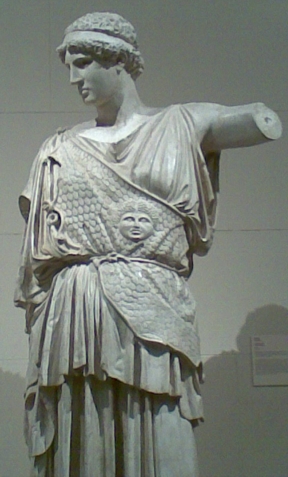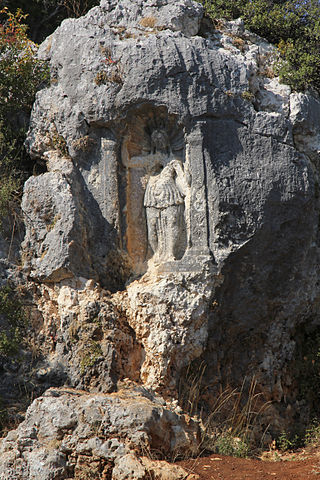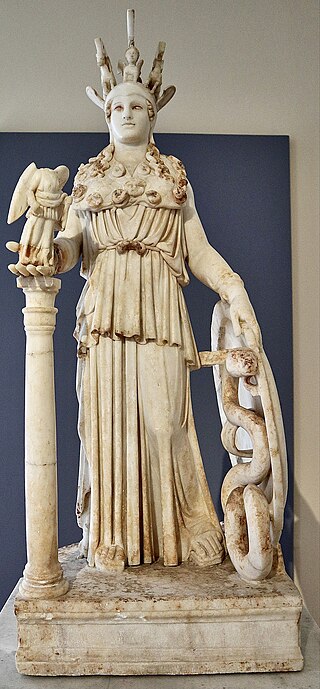
The so-called Mourning Athena is an Athenian marble relief dated circa 460 BC. The relief is 0.48 m high and made of Parian marble. It is displayed at the Acropolis Museum in Athens, inventory no. 695.

The so-called Mourning Athena is an Athenian marble relief dated circa 460 BC. The relief is 0.48 m high and made of Parian marble. It is displayed at the Acropolis Museum in Athens, inventory no. 695.
The goddess, marked by her helmet of the Corinthian type, wears a peplos, clasped at the shoulders and cinched at the waist. She rests her right hand on her hip and crosses her left leg over her right. Her left hand grasps a spear on which she leans, and her head is inclined.
The meaning of her bowed head has been a matter of debate since the relief's excavation from the Acropolis of Athens in 1888. As the conventional name suggests, many have taken the posture to indicate sadness or pensiveness, and thus to interpret the rectangular object on the viewer's right as a stele, a stone slab that serves as a grave marker. Others see an 'exhausted Athena', and others still see no such emotion. The exact nature of the rectangular object, too, is unclear – some suggest that an object was perched atop it (e.g., the infant Erichthonius) – others that it is a marker from a race-course.

The Acropolis of Athens is an ancient citadel located on a rocky outcrop above the city of Athens, Greece, and contains the remains of several ancient buildings of great architectural and historical significance, the most famous being the Parthenon. The word Acropolis is from the Greek words ἄκρον and πόλις. The term acropolis is generic and there are many other acropoleis in Greece. During ancient times the Acropolis of Athens was also more properly known as Cecropia, after the legendary serpent-man Cecrops, the supposed first Athenian king.

The Parthenon is a former temple on the Athenian Acropolis, Greece, that was dedicated to the goddess Athena during the fifth century BC. Its decorative sculptures are considered some of the high points of classical Greek art, an enduring symbol of Ancient Greece, democracy and Western civilization.

The statue of Athena Parthenos was a monumental chryselephantine sculpture of the goddess Athena. Attributed to Phidias and dated to the mid-fifth century BCE, it was an offering from the city of Athens to Athena, its tutelary deity. The naos of the Parthenon on the acropolis of Athens was designed exclusively to accommodate it.

The Temple of Athena Nike is a temple on the Acropolis of Athens, dedicated to the goddesses Athena and Nike. Built around 420 BC, the temple is the earliest fully Ionic temple on the Acropolis. It has a prominent position on a steep bastion at the south west corner of the Acropolis to the right of the entrance, the Propylaea. In contrast to the Acropolis proper, a walled sanctuary entered through the Propylaea, the Victory Sanctuary was open, entered from the Propylaea's southwest wing and from a narrow stair on the north. The sheer walls of its bastion were protected on the north, west, and south by the Nike Parapet, named for its frieze of Nikai celebrating victory and sacrificing to their patroness, Athena and Nike.

The sculpture of ancient Greece is the main surviving type of fine ancient Greek art as, with the exception of painted ancient Greek pottery, almost no ancient Greek painting survives. Modern scholarship identifies three major stages in monumental sculpture in bronze and stone: the Archaic, Classical (480–323) and Hellenistic. At all periods there were great numbers of Greek terracotta figurines and small sculptures in metal and other materials.

The Parthenon frieze is the high-relief Pentelic marble sculpture created to adorn the upper part of the Parthenon's naos.

The Athena Promachos was a colossal bronze statue of Athena sculpted by Pheidias, which stood between the Propylaea and the Parthenon on the Acropolis of Athens. Athena was the tutelary deity of Athens and the goddess of wisdom and warriors. Pheidias also sculpted two other figures of Athena on the Acropolis, the huge gold and ivory ("chryselephantine") cult image of Athena Parthenos in the Parthenon and the Lemnian Athena.

The metopes of the Parthenon are the surviving set of what were originally 92 square carved plaques of Pentelic marble originally located above the columns of the Parthenon peristyle on the Acropolis of Athens. If they were made by several artists, the master builder was certainly Phidias. They were carved between 447 or 446 BC. or at the latest 438 BC, with 442 BC as the probable date of completion. Most of them are very damaged. Typically, they represent two characters per metope either in action or repose.

The Lemnian Athena, or Athena Lemnia, was a classical Greek statue of the goddess Athena. According to geographer Pausanias (1.28.2), the original bronze cast was created by the sculptor Phidias circa 450–440 BCE, for Athenians living on the island of Lemnos to dedicate on the Acropolis of Athens.
Kore is the modern term given to a type of free-standing ancient Greek sculpture of the Archaic period depicting female figures, always of a young age. Kouroi are the youthful male equivalent of kore statues.

In Greek mythology and ancient religion, Nike; Ancient Greek: Νίκη, romanized: Nike, lit. 'victory'; pronounced[nǐː.kɛː], modern: ) is the goddess who personifies victory in any field including art, music, war, and athletics. She is often portrayed in Greek art as Winged Victory in the motion of flight; however, she can also appear without wings as "Wingless Victory" when she is being portrayed as an attribute of another deity such as Athena.

The Athena relief of Sömek is a Greco-Roman rock relief, located some two kilometres north of the village of Sömek in Silifke district of Mersin province in Turkey, near the valley of the Limonlu river, the ancient Lamos. In antiquity, the river formed the border between "Rugged Cilicia" in the west and "Flat Cilicia" in the east.
The Angelitos Athena is an ancient marble statue, which was made around 480–470 BC. The figure, the earliest known depiction of the armed Athena, is an example of the severe style, the transitional style between archaic and classical Greek sculpture which developed after the Persian Wars. Today it is located at the Acropolis Museum under the inventory number 140.
The Peplos Kore is an ancient sculpture from the Acropolis of Athens. It is considered one of the most well-known examples of Archaic Greek art. Kore is a type of archaic Greek statue that portray a young woman with a stiff posture looking straight forward. Although this statue is one of the most famous examples of a kore, it is actually not considered a typical one. The statue is not completely straight, her face is leaned slightly to the side, and she is standing with her weight shifted to one leg. The other part of the statues name, peplos, is based on the popular archaic Greek gown for women. When the statue was found it was initially thought that she was wearing a peplos, although it is now known that she is not.

The Kore of Lyons is a Greek statue of Pentelic marble depicting a bust of a young girl of the kore type, conserved at the musée des beaux-arts de Lyon, France. Deriving from the Athenian Acropolis, it is generally dated to the 540s BC. Considered the centrepiece of the museum's antiquities department, the statue was acquired between 1808 and 1810.

The Varvakeion Athena is a Roman-era statue of Athena Parthenos now part of the collection of the National Archaeological Museum of Athens. It is generally considered to be the most faithful reproduction of the chryselephantine statue made by Phidias and his assistants, which once stood in the Parthenon. It is dated to 200–250 AD.

The pediments of the Parthenon are the two sets of statues in Pentelic marble originally located as the pedimental sculpture on the east and west facades of the Parthenon on the Acropolis of Athens. They were probably made by several artists, including Agoracritos. The master builder was probably Phidias. They were probably lifted into place by 432 BC, having been carved on the ground.

The Athena Marsyas Group was a bronze sculptural group by Myron that stood on the Acropolis of Athens in the high classical period, dated to c 450 BCE. Now lost, it has been reconstructed from copies, coins, other visual sources and literary testimonia. The work depicted the satyr Marsyas picking up an aulos dropped by Athena.

Kore 670 is a Late Archaic Greek kore made of Parian marble, created in 520–510 BC, measuring 1.15 cm.

Nike Fixing her Sandal, also known as Nike Taking off her Sandal or Nike Sandalbinder, is an ancient marble relief of the Greek goddess of victory Nike in the process of fixing or removing the sandal of her right foot. This fifth-century BC sculpture originally adorned the Temple of Athena Nike in the Acropolis of Athens, and now it is kept in the Acropolis Museum of Athens, in Greece.